I have not had the opportunity to do much green screen work, either by myself or working with others. This type of video can be expensive and time-consuming. On the occasions I have worked on them, I am aware that if you want quality results, you really need to plan what you are doing. The below example was shot fully in a small studio using the kind of green commonly available.
|
FKA “Be Myself” (Studio filmed, using a Green Screen) |
All of this footage was shot in a studio using a green screen. There are two main backgrounds. The background for the very end and beginning are time-lapse photography taken on the streets of Leicester, the home town of the band. The main background is a virtual set of stacked amps and monitors of various kinds. Each amp or monitor was photographed against a green screen and composited, using PhotoShop, onto a master background. |
Once clear of the video’s introduction, as the lead singer walks off the street and into the studio, the music video starts off simply. The camerawork and editing follow a more conventional performance-based music video. As the song progresses, the compositing becomes more complex, and toward the end of the song the elements are combined in more abstract ways. By the very end – we return to a more conventional performance music video, and at the very end the lead singer walks back out of the studio and back on to the streets of Leicester.
|
FKA “Be Myself” (Short ‘Making of’ Video) |
This is a short ‘making of’ video showing the green screen filming, and then how one of the sequences was built up from different shots of the band members. You can see in the footage of the actual filming it is only a small studio and a small green screen. Multiple cameras are recording at any one time, catching the band members in a range of shots, from wide shots to close-up shots. With the band-members caught from different angles, these can then be used to construct the sequences required. |
The music video starts as a more traditional performance based music video, and then ends as a more unconventional abstract performance. Because the overall look of the video was to have camerawork and editing that followed a more traditional performance based music video, I hoped I could get away with filming the band members with very flat, basic lighting. They would look like they were in a dark, dank, smoke-filled studio and I would concentrate on trying to make sure the green screen was as well lit as possible to cut down on the time-consuming compositing work.
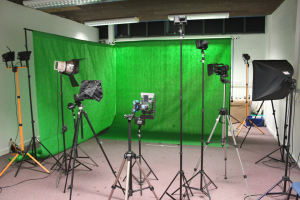
|
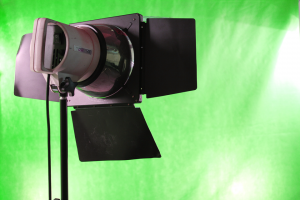
|
As you can see from the photo taken in the studio – it’s a small space. This was an attempt to do a complex green-screen music video on a budget. Most of the lights that were available were trying to cover the green screen as evenly as possible. Trying to do this, plus provide the minimum of lighting for the band members proved difficult.
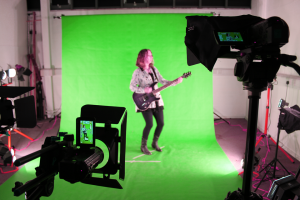
|
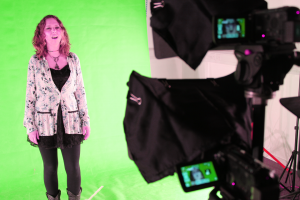
|
Ultimately, I wasn’t able to light the green screen as evenly as I would like. This is a problem as it results in shots where you have to spend additional time cleaning up the mattes created when using chroma-key/matte-creation tools in Premiere/AfterEffects. This was the compromise of not booking a £50-per-hour studio for a day where you can rely on the facility, and your own equipment, to be enough. If you rent for a day, you then have enough time to set-up properly, record what you need, and go home at the end of a day. If this has been shot at a professional film/TV studio, it would have taken only a day, but that’s £400 before any additional costs like my fee for filming and editing.
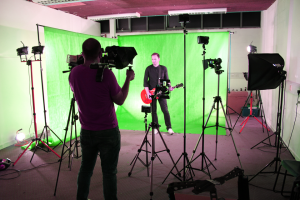
|
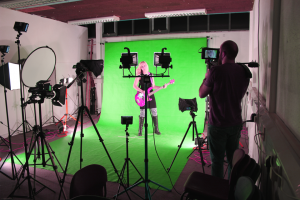
|
In the end, it took at least an hour to film each band member. Because the lead singer had to do an additional set of shots for the beginning and end of the video – that was another hour. These were filmed over two evenings, totalling about six hours work. Every time a band member was filmed – multiple cameras (five in all) were filming at any one time. This meant they were capture in wide, medium and close-up shots – filmed in HD. In future, I see it being easier to hire one or two 4K cameras: film in 4K in both a wide/full-length shot and a medium shot, and then crop the 4K footage to HD framings as required. Different takes were required because of angling the cameras so we could record footage that allowed us to simulate seeing the band from head-on (the most common framing) or from either left or right of the band (to add variety in cutting).
